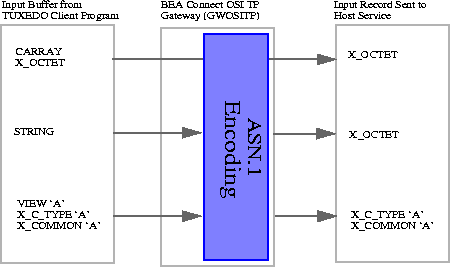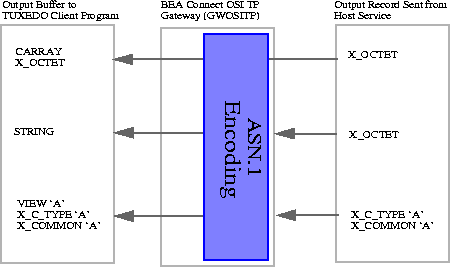- X_C_TYPE
BEA Connect OSI TP uses typed buffers to transmit and receive data. BEA Connect OSI TP supports the following buffer types:
XATMI (X/Open Application Transaction Manager Interface) mappings to OSI TP are defined in the XATMI ASE (Application Service Element). BEA Connect OSI TP supports this combination. Interoperability using Connect OSI TP requires that remote systems support XATMI ASE.
Therefore, TUXEDO-specific buffer types, such as STRING, VIEW, and CARRAY may need to be converted into XATMI standard types. BEA Connect OSI TP Gateways perform these layout conversions implicitly.
Abstract Syntax Notation 1 (ASN.1) is an international standard that provides a canonical representation to deal with data representation differences such as byte order, word length, and character sets. The local Gateway (GWOSITP) encodes input from the local client program. It produces an ASN.1 encoded record that is sent to the remote service. When a reply is received, it is decoded before being returned to the client. Similarly, when remote requests for local services are received by the local Gateway, they are decoded from the ASN.1 format. Replies are then encoded for return to the remote client.
The local Gateway (GWOSITP) maps input buffers to input records based on information found in the configuration setting for the local and remote services. The following summarizes all the mapping possibilities:
As illustrated, the mapping possibilities include:
Layout Conversion for Buffer Types
ASN.1 Encoding
Summary of Mappings
Figure 5-2 Input Mappings

While the previous figure illustrates input mapping, output mapping follows exactly the same paths but in reverse.
TUXEDO application programs that send requests through BEA Connect OSI TP are developed like other TUXEDO application programs.
Information on the supported ATMI calls and recommendations for selecting the buffers used in application programs are the major considerations for programmers.
The request/response calls supported by BEA Connect OSI TP are the following:
Figure 5-3 Output Mappings

Application Programming
Supported ATMI Calls
The conversational calls supported by BEA Connect OSI TP are the following:
Consider the following recommendations when selecting buffers in application programs.
Considerations for Selecting Buffers
Because mapping keeps system dependencies out of application code, it may be thought of as a system programming (or an application administration) activity. System programming activity is done once VIEWs have been defined and VIEW files have been compiled.
Work with the application programmers for the host system to determine the input and output record layouts for the remote application programs. Create standard TUXEDO VIEW definitions in files.
TUXEDO VIEW definitions in files, compile the VIEW files by running the viewc VIEW compiler.
If necessary, set the VIEWFILES, VIEWDIR, FIELDTBLS, and FLDTBLDIR environment variables using a TUXEDO ENVFILE so that BEA Connect OSI TP servers can locate binary VIEW files and field table files at runtime.
System Programming
Defining VIEWs
Compiling VIEW Files